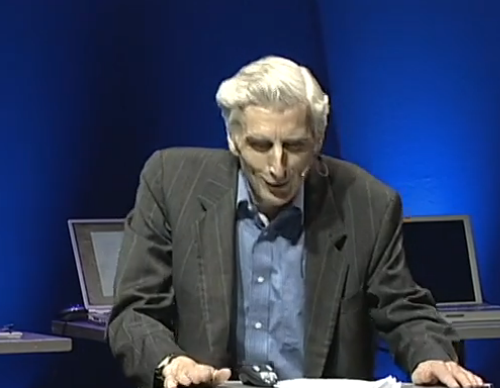If you take 10,000 people at random, 9,999 have something in common: their interests in business lie on or near the Earth's surface.
如果你隨機(jī)挑選出10000個(gè)人,其中的9999個(gè)人會(huì)有如下共性:他們對(duì)商業(yè)的興趣顯而易見。
The odd one out is an astronomer, and I am one of that strange breed. My talk will be in two parts.
余下的那位怪人是天文學(xué)家,而我就是這個(gè)奇特物種中的一員。我的發(fā)言將分為兩部分。
I'll talk first as an astronomer, and then as a worried member of the human race.
首先作為一個(gè)天文學(xué)家發(fā)言,之后作為人類社會(huì)中憂心忡忡的一員。
But let's start off by remembering that Darwin showed how we're the outcome of four billion years of evolution.
讓我們首先回顧達(dá)爾文所指出的:我們?nèi)祟愔皇?0億年進(jìn)化的產(chǎn)物。
And what we try to do in astronomy and cosmology is to go back before Darwin's simple beginning, to set our Earth in a cosmic context.
我們進(jìn)行天文學(xué)和宇宙學(xué)研究要做的,就是回溯到達(dá)爾文的理論原點(diǎn),將我們的地球置于宇宙的背景中。
And let me just run through a few slides. This was the impact that happened last week on a comet.
請(qǐng)?jiān)试S我展示幾張圖片。這是發(fā)生在上周的一次撞擊彗星實(shí)驗(yàn)。
If they'd sent a nuke, it would have been rather more spectacular than what actually happened last Monday.
倘若他們發(fā)射的是顆核彈的話,其景象將會(huì)更加壯觀。圖片顯示的是上周一的實(shí)景。
So that's another project for NASA. That's Mars from the European Mars Express, and at New Year.
那是NASA(美國(guó)國(guó)家航空航天局)的又一個(gè)項(xiàng)目。這張是在新年時(shí)由歐洲“火星快車號(hào)”探測(cè)器拍到的火星。

This artist's impression turned into reality when a parachute landed on Titan, Saturn's giant moon.
藝術(shù)家的創(chuàng)想變成了現(xiàn)實(shí),當(dāng)一個(gè)著陸裝置降落在土星的巨大的衛(wèi)星泰坦(土衛(wèi)六)上。
It landed on the surface. This is pictures taken on the way down. That looks like a coastline.
它降落在土衛(wèi)六的表面。這張圖片拍攝于著陸途中。那些看起來像是海岸線。
It is indeed, but the ocean is liquid methane -- the temperature minus 170 degrees centigrade.
它們確實(shí)是,但“海洋”是液態(tài)的甲烷 - 溫度是零下170攝氏度。
If we go beyond our solar system, we've learned that the stars aren't twinkly points of light.
如果我們放眼到太陽系之外,我們已經(jīng)知道恒星并不是不斷眨眼的光點(diǎn)。
Each one is like a sun with a retinue of planets orbiting around it. And we can see places where stars are forming, like the Eagle Nebula.
每一顆恒星都像太陽,伴有若干行星環(huán)繞。我們可以看到恒星形成的區(qū)域像天鷹星云(M16)。
We see stars dying. In six billion years, the sun will look like that.
我們還能看到衰竭的恒星。六十億年后,太陽將變成這樣。
And some stars die spectacularly in a supernova explosion, leaving remnants like that.
有些恒星在壯觀的超新星爆發(fā)中消亡,遺留下這樣的殘余。











